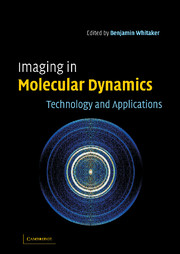Book contents
- Frontmatter
- Contents
- List of contributors
- Preface and acknowledgements
- List of abbreviations
- Part 1 Technology
- Part 2 Applications
- 8 Kinematically complete imaging of molecular many-body fragmentation: coincident multi-particle detection and analysis
- 9 Collisions of HCl with molecular colliders at ~ 540 cm-1 collision energy
- 10 Measurement of state-resolved differential cross-sections of bimolecular reactions using single beam velocity mapping
- 11 Slice imaging: a new approach to ion imaging and velocity mapping
- Index
11 - Slice imaging: a new approach to ion imaging and velocity mapping
Published online by Cambridge University Press: 07 August 2009
- Frontmatter
- Contents
- List of contributors
- Preface and acknowledgements
- List of abbreviations
- Part 1 Technology
- Part 2 Applications
- 8 Kinematically complete imaging of molecular many-body fragmentation: coincident multi-particle detection and analysis
- 9 Collisions of HCl with molecular colliders at ~ 540 cm-1 collision energy
- 10 Measurement of state-resolved differential cross-sections of bimolecular reactions using single beam velocity mapping
- 11 Slice imaging: a new approach to ion imaging and velocity mapping
- Index
Summary
Introduction
Houston and Chandler introduced ion imaging in 1987 [1], demonstrating for the first time the potential of this method to be used in chemical dynamics studies. In most chemical dynamics experiments the desired quantity to measure is the state-resolved differential cross section (dσ/dΩ) [2]. This quantity is defined as the amount of product of a chemical reaction, be it a half collision (photodissociation) or a full collision, that is scattered into a unit solid angle per unit of time. Borrowing from the methods of nuclear physics, the pioneers of scattering experiments used the time-of-flight method (TOF) [3] coupled to a rotatable detector to map out dσ/dΩ. Initial experiments employed a universal ionizer to ionize and subsequently detect the products [3]. The universality of the method made it the most successful method for studying a large number of reactive collisions. However, its limited energy resolution was insufficient for detailed studies of unimolecular processes.
It was quickly realized that using high-resolution laser spectroscopic detection of the products would yield a great deal more information than the universal detection [3]. In order to obtain information concerning dσ/dΩ the most popular methods used were Doppler spectroscopy, TOF, or Doppler coupled with TOF [3]. Ion imaging was introduced as a method that combined Doppler and TOF. Its major drawback was its limiting energy resolution, typically 15-20%, coupled with the ‘magical and mysterious’ inverse Abel transformation.
- Type
- Chapter
- Information
- Imaging in Molecular DynamicsTechnology and Applications, pp. 227 - 246Publisher: Cambridge University PressPrint publication year: 2003
- 1
- Cited by

